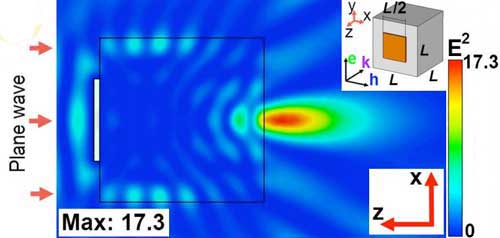| Posted: Apr 27, 2018 |
Scientists verify a way of how to improve resolution of most powerful microscopes
(Nanowerk News) Researchers from Tomsk Polytechnic University (Russia) and Bangor University (UK) have experimentally verified anomalous amplitude apodization for non-spherical particles for the first time. This phenomenon makes it possible to boost the magnifying power of microscopes and to more effectively record molecules and viruses. The study results were reported in Journal of Infrared, Millimeter, and Terahertz Waves ("A Millimetre-Wave Cuboid Solid Immersion Lens with Intensity-Enhanced Amplitude Mask Apodization").
|
 |
| Simulated near-field E 2 field enhancement distribution on xz plane with the amplitude mask apodization. (Image: Tomsk Polytechnic University)
|
|
"If we mask part of an ordinary lens surface with an optical filter, it will increase the magnifying power of the lens. But peak field intensity drops dramatically. The same effect is typical of spherical particle-lenses in nano-scopes or high-definition optical microscopes with a magnifying power of 50 nanometers. If we use non-spherical particles, including cylinders with illuminated butt-ends, as lenses, and if we mask part of the surface, it will simultaneously boost their magnifying power and peak field intensity. This is called the amplitude mask apodization effect," Professor Igor Minin from Tomsk Polytechnic University's faculty of electronic engineering noted.
|
|
Non-spherical particles function as super-lenses accumulating evanescent (damp) waves that can form an image with unprecedentedly high definition levels.
|
|
In their work, scientists cite experimental data confirming the existence of the amplitude mask apodization effect in the millimeter waveband. During their experiments, cuboid dielectric particles, part of whose surfaces (about 45 percent) are covered with a copper amplitude mask, showed a 36-percent increase in magnifying power, with peak field intensity levels increasing by over 30 percent.
|
|
You could say that spherical particle-lenses boost the magnifying power of nano-scopes only through the loss of energy. But when we use non-spherical particles, the magnifying power increases at a rate commensurate with the greater peak field intensity levels," Minin added. The long-term development of this technique will make it possible to obtain images of large biological molecules, viruses and the internal elements of living cells using non-spherical particles.
|
|
Experts will no longer have to painstakingly prepare various samples. For example, this is an important aspect of fluorescent microscopy. The amplitude mask apodization effect has a wide range of applications where sub-wavelength focusing is required. These are medicine, non-destructive testing, flaw detection, on chip processing and data transfer systems, etc.
|

